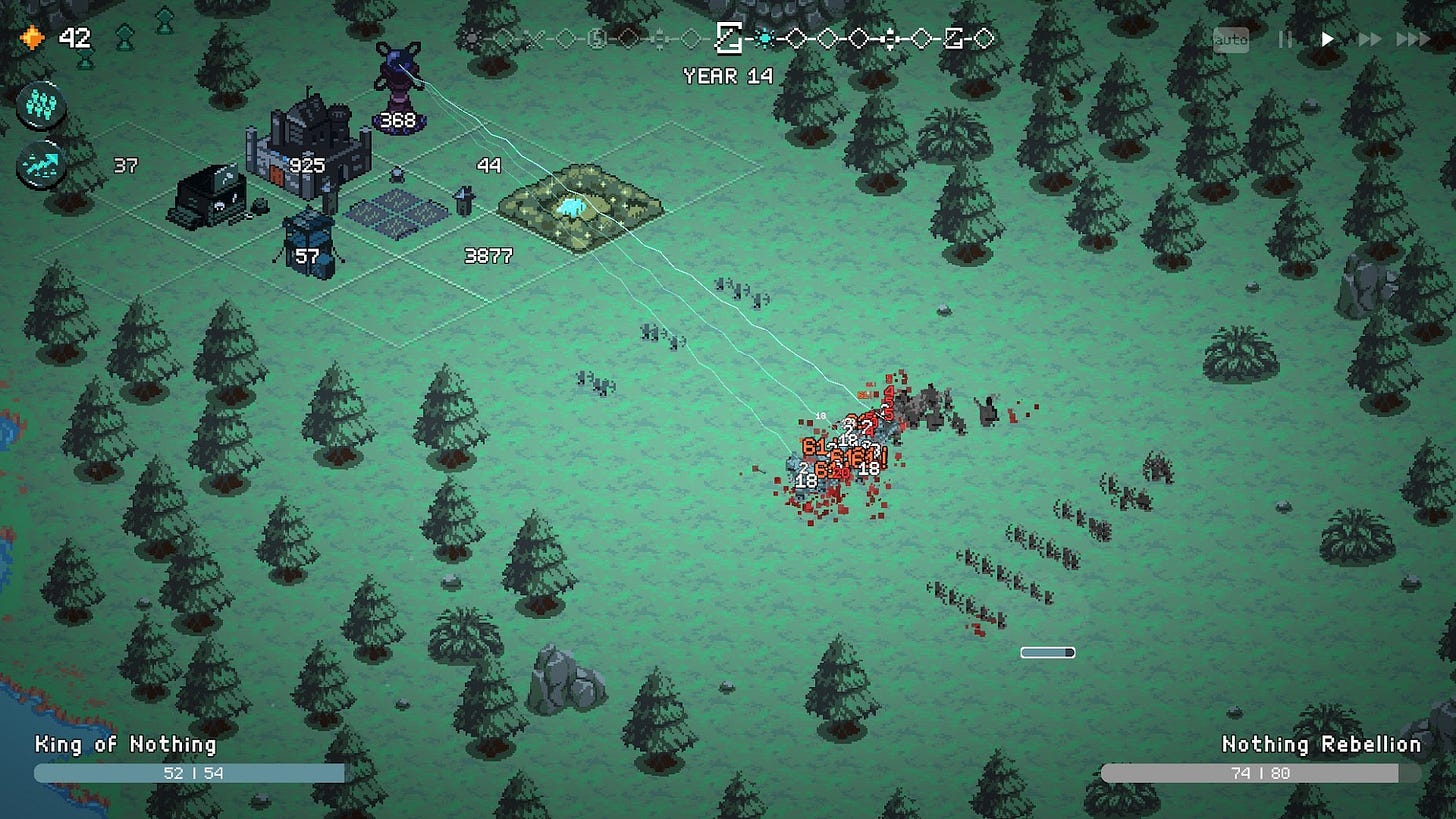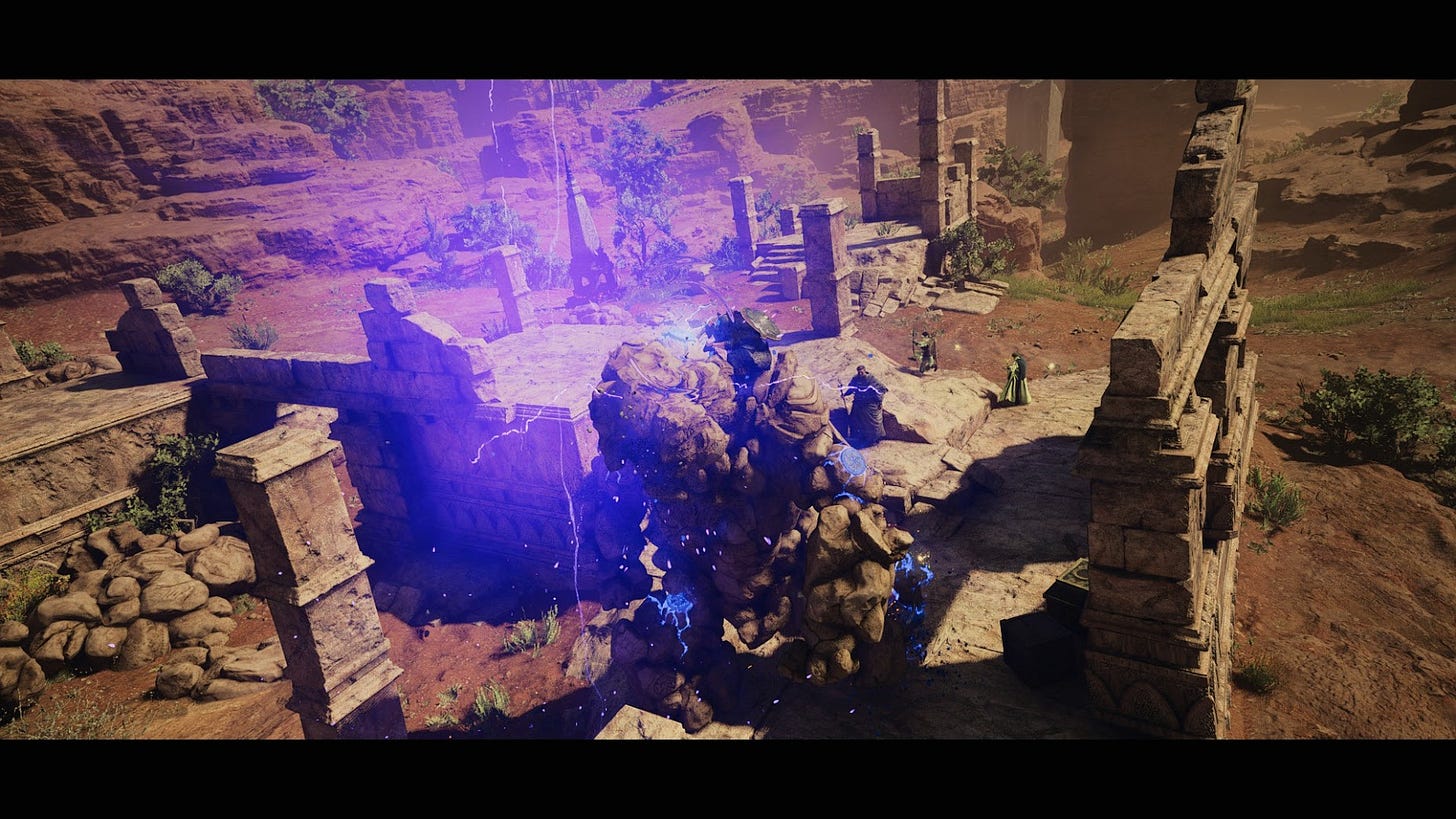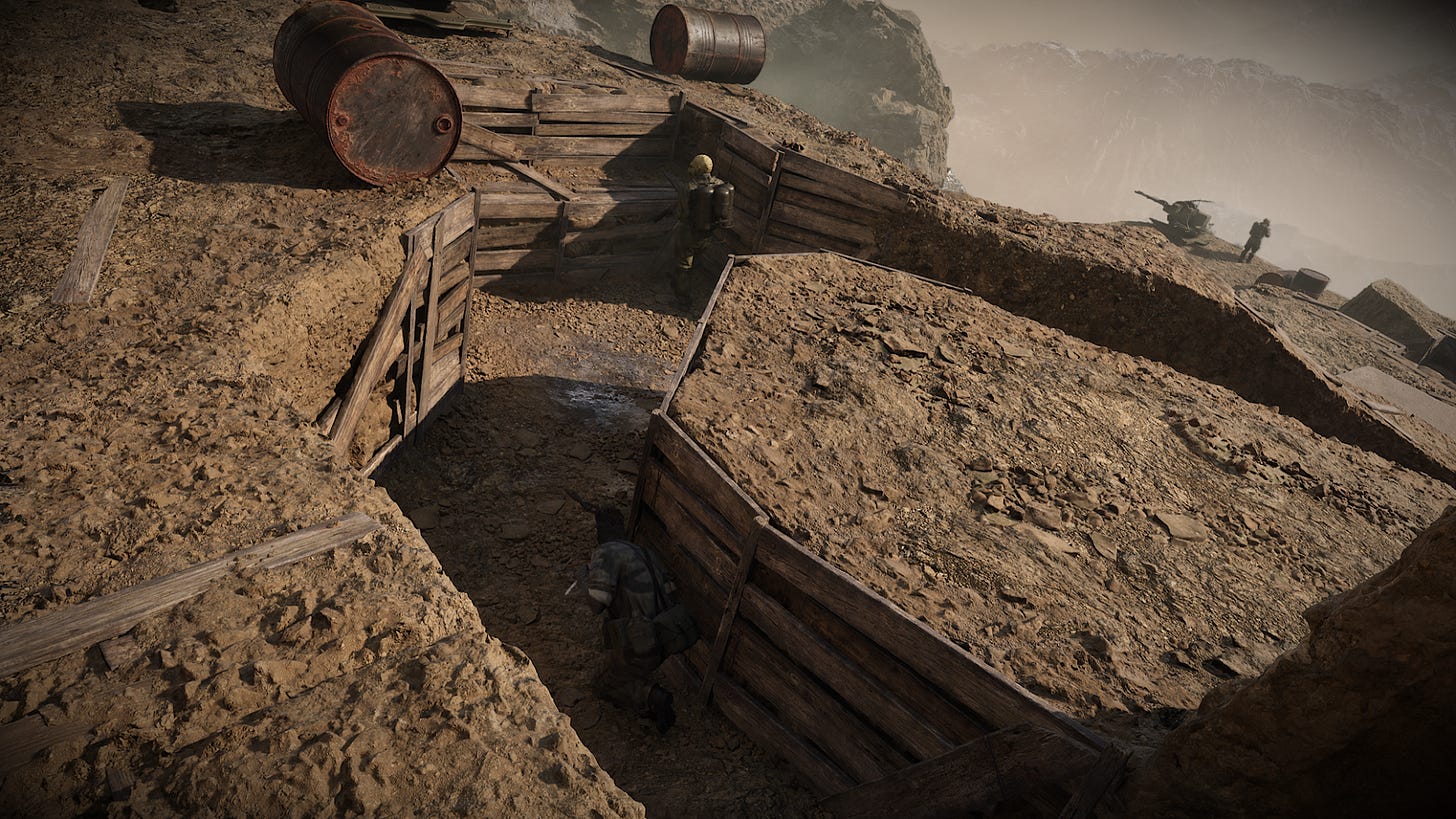The Game Enjoyer: Issue 5
Of dragons, snakes, kings and stars
We’re at the tail end of the year, and after having spent August and September immersed in Death Stranding 2, I’ve finally opened my heart up to more games after having it broken by Kojima’s latest production. The polar nights take over daytime in Reykjavík, and with this nigh-permanent darkness I sit down to write about my latest game-enjoying adventures. After a quick run through of The Last of Us: Part II, which was a breath of fresh air for my girlfriend after she was slightly let down by the TV show’s second season, we give a quick thought at what cinematic game we’re gonna play next. Eventually we decide for Kojima’s James Bond inspired stealth masterpiece, now remastered for the new generation.
My Snake is exposed in Metal Gear Solid Delta
I have a love-hate relationship with stealth games. I love many games that are supposed to be stealth, but aren’t particularly challenging when it comes to the sneaking itself. Assassin’s Creed, The Last of Us, and recently, Ghost of Tsushima, Days Gone and even Death Stranding itself are games that involve the player in different degrees of stealth gameplay, and yet they’re always somehow so simple.
The ability to mark enemies and follow them through walls, the comfort of tall grass and other debris that makes you practically invisible, and predictable enemy behaviors makes these games not so difficult when it comes to stealth. At least, even if I get caught, their action is nimble enough that I can finish off the segment through violence. I’ve rarely had to reload a previous save in these games simply because I was caught by enemies.
That isn’t the case in Metal Gear Solid Delta. With my usual stubbornness, I start the game on Hard difficulty (not Extreme or European Extreme, because I know I would regret it) and after approximately 30 minutes of gameplay and 90 minutes of cutscenes, we’re through the Prologue and into the game proper. There is something about this game that feels like a humiliation ritual to me. The gameplay itself feels slightly clunky (and apparently, from what veterans of the franchise claim, it plays slightly worse than the original version), but it’s just so good; the camouflage system, the sandbox of weapons and tools at your disposal, the variety of enemy behaviors, the different paths and ways you can move through the different areas… All of this comes together to form a challenge that is not unsurmountable to me, but just extremely difficult, for some reason.
No matter how careful I am or how much I think I am aware of enemy positions, it takes one step in the wrong direction, or one second of hesitation, and suddenly a guard has decided to turn his head towards me, or has turned a corner faster than I expected. Suddenly, the alarm is rang and several guards armed with rifles, shotguns, and ballistic shields are rushing the area looking for me, while I lay under a bedframe or half naked in a patch of tall grass, waiting for the alarm to be called off.
On another occasion, I spot on a guard the characteristic color of a film tape. I know these are collectibles that must be taken from them when you hold them up, so I do a quick round of recon around the area, then I formulate a plan. This guard periodically checks a room in the back of a cabin. I can sneak into this room from a hole in the floor, but the room is divided in two by a row of boxes to climb over, slowing my advance from one side to the other. To ensure that the guard won’t see me climbing, I place a magazine on one side of the room, then go back behind the boxes and wait. There is so much waiting in my gameplay of MGS Delta. Finally, he takes the bait, I sneak up behind him and hold him up with my gun. He raises his hands, I walk around him and point the gun at his head, triggering him to shake off any items he can give me. Somehow, the tape pops up from him straight towards Snake, and I heard the crunching sound of the tape breaking, signaling that I lost my chance to collect the item.
This particular attempt was after 6 failed attempts at collecting this tape, and sometimes ignoring the tape and simply wanting to collect the resources hidden in the cabin. Eventually I gave up; whatever is in that tape is not so important that I want to waste any more time running around this cabin for another half hour. Making my way out is somehow even harder, eventually I collect everything, make my way out, blow up a storage room in the process, and continue my path towards the Mountain Base.
One day I will learn how to play stealth games, but for now, I painstakingly advance through a masterclass on flunked tactics, unnecessary violence, and the art of waiting for minutes until stars align.
All-out war in 9 Kings
Due to my job having me work on rotating shifts, including a nocturnal one, I often find myself trying to stay awake overnight at home, in preparation for being awake overnight at the office. In order to do so, this month I purchased a few indie games that were in my wishlist. One of them was 9 Kings, a simple roguelite tower defense game that has hooked me like no game has done in a long time.
The gameplay loop is simple: you start a run as one of the 9 titular kings. You have a grid where you can place cards every round; some cards are troops that fight for you on the field, other cards are towers that attack enemies on the field, and other cards are buffs for your troops or buildings, or buildings that provide other benefits. After you place enough cards (once you have two cards in your hand the next phase begins), you fight the troops of an enemy king. Defeat them, and you can loot a card from that king’s deck. Lose, and you lose one life (out of 3), and you get to pick a card from your own deck.

Through the game, other things happen, typical from this kind of games: a merchant comes to let you purchase cards for money, or a spire appears to give you the chance to expand your grid. Once per run you have the chance to earn a blessing for a specific spot on your grid. There is a lot of tactical nuance and strategy to 9 Kings, but the runs last between 20 and 50 minutes at max, and overall the experience is really fluid and quick.
In my best run so far, I used the King of Greed. Using Dispensers, a kind of machine gun that shoots faster every time you earn money, and Mercenaries, a troop slot that has more troops the more money you accumulate, I conquered the first 20 rounds as a bolstered my forces. An enchantment on my Mercenaries gave them a chance to give me money for each enemy they killed, while the Vault in my base gave me money each round, and the Beacon furthered the attack speed of my Dispensers and Mercenaries. A normal run could end at round 33, but after I beat it, I got all the way to round 84 before I finally lost.
I heavily recommend this game for anyone who has some time to kill and likes games that reward thinking mathematically and placing structures in a grid to maximize benefits.
Challenging myself with Ixion
Another of the indies I picked up for my overnight sessions was Ixion. I have a passion for science-fiction; Star Wars, Halo, Mass Effect, Dune, and Star Citizen are just a few names that come to mind when I think what sci-fi universes I love the most when it comes to videogames, movies or literature.
I also have a penchant for some kinds of strategy games. Tower defense and city builders are right up my alley. Real time strategy is harder for me, but I can enjoy it if the micromanagement is kept to a minimum. Grand Strategy and 4X are intriguing to me, but every foray I’ve had into a game like that has ended with extreme frustration and catastrophic failure. When I saw Ixion, a city builder/survival strategy game, not so different from Frostpunk, but with the added benefit of it being set on a space station, I didn’t think it twice and decided I would try it.
From the beginning, I decided to crank the difficulty all the way up to challenging. In the words of the game: Challenge mode allows you to earn an exclusive achievement.

Say no more. With no idea of how the game works or what it’s about, I set the difficulty to Challenge, and embark on my journey. From the beginning I can see that the plot of the game actually matters in Ixion. Some lore and cutscenes set me in my position as the administrator of the Tiqqun, the space station that I will be overseeing. In Challenge mode, things can spiral into disaster quickly, but thankfully the Prologue of the game is still calm enough that I can learn the ropes without much fuss.
However, soon after beating the Prologue, my decisions start gaining weight. In Ixion, gameplay is divided on three layers of level design. The station’s interior, divided in 6 sectors, is where I choose where to build what. Each building serves a purpose and requires an amount of workers, and striking a balance between maintaining functionality, proper power usage and the health of the workers can be difficult in an of itself. Starting with only one sector unlocked, it takes good planning and a bunch of resources to open up the rest of the station. Directly interacting with the interior of the station is the exterior, where we can build different upgrades for the station, like solar panels that provide power for the buildings, or hull or engine upgrades that allow the Tiqqun to tolerate harsher environments as we move it through space. And then there’s the third layer, space itself. Ixion is not only about maintaining the Tiqqun in working order, but also about doing so while we purposefully move it as we explore the stars in search of answers and solutions to our problems.
It is this trifecta of managing the interior, maintaining the exterior and making the right choices in the exploration part that makes Ixion so challenging. In a particularly rough moment of my gameplay so far, I decided to move the Tiqqun towards a specific location to explore a possible quest. While moving, the ship does not use its solar panels, and so your station is powered by whatever you have stored in however many batteries you’ve built. Unfortunately, I didn’t prepare enough, and halfway through the trip my station blacked out. Without power, the EVA airlocks which allowed my workers to perform maintenance on the station’s exterior would not work, and by the time my station arrived to its destination, the hull was in pieces. I earned the achievement for managing to bring the station back from under 5% of hull integrity after this.
Ixion’s challenge mode can be very punishing for those who make reckless decisions, but I have found that it is also very flexible in allowing you to overcome obstacles after making bad choices. Disabling or dismantling buildings to get back the power or resources from them can always be done in a pinch, and those buildings can be reactivated or rebuilt later on. Running out of an important resource puts you on a timer to find more before you’re doomed, but even I, the self-proclaimed worst strategy gamer of all time, have managed to grasp survival from jaws of defeat at least three times in my first playthrough, and I’ve only come out a little bit stressed from it.
In other words: if you enjoy survival and strategy games, you will enjoy Ixion. And yes, I particularly recommend Challenge mode for that extra bit of suspense when choosing to expand to one more sector or move the station to that location over there.
Following my heart in Dragon’s Dogma 2

Picking it up from my backlog back in mid-September, I have found Dragon’s Dogma 2 to be everything I wanted from an RPG in these past few months. Most importantly, I have realized that, after all, Dragon’s Dogma 2 (as well as its prequel) is a Strand-type game.
Ever since I beat Death Stranding for the second time, I have been thinking on what games fit into this “Strand-type” sub-genre and what features it entails. A Strand-type game must not feature any kind of direct multiplayer gameplay, and instead involve multiplayer interaction through building connections. At the core of what defines the Strand is the idea of players connecting through gameplay despite never playing directly together. This is why I don’t consider games like Helldivers 2 or Dark Souls to fit the Strand-type. While they involve some degree of collaboration or asynchronous interaction, both feature direct co-op play and not a meaningful impact on other players’ worlds without it.
In Dragon’s Dogma 2, we connect with other players through sharing and recruiting Pawns, the game’s mechanic that allows us to build a party of adventurers. With your main character and your main Pawn being created by yourself, the game allows you to hire up to two extra Pawns, which can be created by the developers themselves, or by other players. But sharing Pawns between players isn’t what makes Dragon’s Dogma 2 a Strand-type game, it’s how the Pawns behaves that truly impacts your world, and therefore fits the genre.
When you discover secrets, like locations of treasure, secret dungeons or hidden Riftstones, your Pawns learn this. When you fight an enemy in an unconventional way, like pushing enemies off cliffs to kill them, or tripping a cyclops to be able to hit it in the eye, your Pawns learn this. Basically, any discovery you make in game is noted by your Pawns, which then share this information with other players. In the case of your Main Pawn, that means that when they are summoned by another player, this Pawn can share these secrets with them. In the case of recruited Pawns, they can share this info when they return to their original player.
From the opposite perspective, your Pawn may learn the location of a treasure or the solution to a quest from another player, and offer to guide you when you reach that point. Pawns that you recruit from other players also have knowledge of certain things and they offer you the chance to follow them into the discoveries. The game cleverly caps this feature by giving you the chance to give four different orders to your Pawns, by saying “Go” or “Help” to signal to your Pawns that you want to be guided, while “Wait” or “To Me” signals that they should stick to you and not go off towards any specific place.
Since recruited Pawns do not level up (as opposed to your main Pawn), the game encourages you to visit Riftstones often to see if there are any higher level Pawns available. These aren’t just stronger in battle, but are also likely to know more secrets to help you as you explore, and to be more proficient in combat by applying player used techniques rather than their normal NPC combat routines.
I’m having a great time with Dragon’s Dogma 2 overall, because it has great graphics, great gameplay, an interesting story, a fantastic sandbox, and it runs great in my rig with all bells and whistles. But on top of everything, I am having a great time with it because every time I sit down to play, explore the world, fight monsters and complete quests, I am interacting with other players, taking advantage of their progress to make my life a bit easier, or giving information to their Pawns to help them in the future.
This reminds me a lot of buildings and signs in Death Stranding and its sequel, and has done nothing but enhance what would already be a fantastic gaming experience.
That’s all for this month’s issue. As opposed to these last few months, I have spent more time now playing many different games. I have been enjoying gaming a lot more ever since my summer vacation, and I feel really energized to tackle on all of these different genres. I’m hoping to have more words to write about more games for the remainder of the year, as I prepare to play Megabonk, The Outer Worlds 2, and either Hell Is Us or Mafia: The Old Country.
If you have enjoyed this article, consider subscribing, sharing it, leaving a comment or restacking it. I have really enjoyed these first few months of writing on Substack, joining the community, and interacting with others. I believe The Game Enjoyer is here to stay! But there will be changes to future issues as I see what works and what doesn’t.



